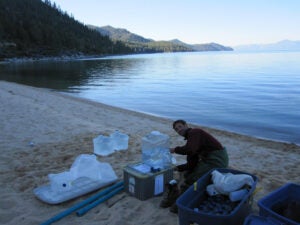(Collaborative research project with Dr. Sergio Sanudo-Wilhelmy)

Pre-filtering large volume samples at Lake Tahoe, Summer 2011
Project Abstract
The productivity of many aquatic ecosystems is often limited by the availability of a key nutrient. In the oceans and in some lakes nitrogen is often that key limiting nutrient. Nitrogen, which is critical for life, occurs in diverse chemical forms including nitrogen gas, ammonium, nitrate and various organic species such as amino acids (the building blocks of proteins) and nucleic acids (the building blocks of DNA). Nitrogen can be converted among these species by various microbes which thereby affect the relative availability of forms of nitrogen useful to plants (e.g. nitrate and ammonium) and higher organisms. Nitrogen cycle processes may themselves be limited by other nutrient factors. For instance, many of the key enzyme reactions in the biological nitrogen cycle require metals for their activity. In particular, molybdenum, is a required component of the enzymes of the nitrogen cycle pathways involved in the uptake of nitrate (nitrate assimilation) and nitrogen gas (nitrogen fixation). In lake ecosystems, a major unknown is how nutrient trace metals that generally exist at very low concentrations control the cycling of nitrogen. The main objective of this study is to determine how the chemical form of nutrient trace metals, such as molybdenum (as well as iron and copper), affect the capacity of organisms to take them up. Studies will be undertaken in three lakes in California and Nevada with contrasting productivity and trace metal concentration. Whereas the uptake of nitrate and nitrogen gas is often controlled by iron availability in marine systems, it is hypothesized that in lakes the limiting trace element for these processes is molybdenum. To test this hypothesis, the PI’s have developed new analytical techniques that measure the different chemical species of molybdenum in these lakes.
This project will provide considerable new information on the importance of metal availability and form in controlling key nitrogen cycle processes. High quality data on metal abundance in lakes is scarce. These studies will therefore provide information on how metal loading has changed and affected these systems over time. Extensive development and subsequent human perturbations have occurred since the earlier intensive studies were conducted in the watersheds of some of these lakes. The project will provide employment and training in state of the art techniques and approaches for undergraduate, graduate students and postdoctoral associates. The PIs teach at both the graduate and undergraduate levels and are active in K-grey education and outreach programs. Both are activists in increasing gender and ethnic diversity in the environmental sciences. The results will be widely disseminated through presentations and publications.

Troy processing samples on the beach, Tahoe 2011
See Also:
Tahoe Environmental Reasearch Center, UC Davis
Deli Wang, Robert C. Aller, Sergio A. Sanudo-Wilhelmy (2011).
Redox speciation and early diagenetic behavior of dissolved molybdenum in sulfidic muds.
Marine Chemistry, v.125, 2011, pp. 101-107
Isabel Romero et al. ASLO Aquatic sciences meeting 2011: Poster Presentation (pdf)